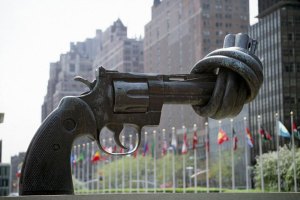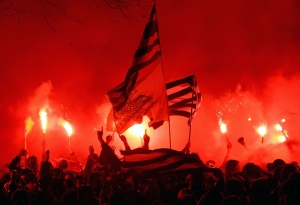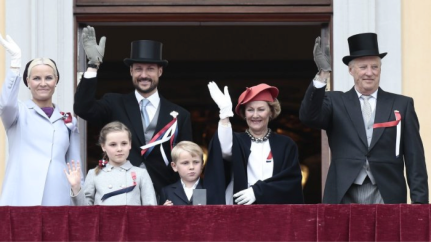In his book Banal Nationalism (1995), Michael Billig discusses the emergence of a nation through clusters of semiotic practices that pass unnoticed, reaffirming the notion of nationhood. These kinds of symbols stay in the centre of everyday life, repeatedly reproduced by the press and, in cases, institutionalized by the state, ready to be used at will. Does nationhood “provide a continual backdrop for political discourses, cultural products, and social life” (Billig, 1995: 8)? What is the significance of ‘banal’ on the nationalist discourse? And, if we agree with Malesevic that identity is an ideological device that relies on myths and ideologies to purify its meaning, making them ‘obvious and innocent’ (Malesevic, 2006: 3), to what extend does ‘banal’ nationalism influence the construction of the national self?
Tantfraktion
When one thinks of Swedish nationalism, it is not strong patriotic flag waving that springs to mind. Especially not for someone living in Sweden. Swedish nationality centres, one could argue, around different ideals. The quiet confirmation of people’s equal rights and the importance of human rights. The long history of so called neutrality from warfare and a background with a strong Social democratic state building model has centered Swedish national identity around ideas of Sweden and Swedes being strong advocates of peace and human rights, moreso than other nations (Åke. Svensk mentalitet:ett jämförande perspektiv, Stockholm: Rabén Prisma, 1998 3rd edition). The core values can be seen in many instances, and perhaps even alluded to in something as innocent as one of Sweden’s favourite Brown Bear, Bamse; the nice bear that is friends with everyone in the forest, yet also eats his honey to become strong and beat up bullies.

Another famous example of Swede’s commitment to peace and human rights can be seen with the famous sculpture of a gun with an upturned knot known as “non- violence” by Carl – Fredrik Reuterswärd.

So when an artist wants to put up a statue of an old woman that hit a neo-nazi over the head during a right wing demonstration one could perhaps assume it is in line with artistic symbols of Sweden. (Please read here for more details: http://www.washingtonpost.com/blogs/worldviews/wp/2015/02/28/sweden-blocks-plan-to-honor-woman-who-hit-a-neo-nazi-with-a-purse/?tid=sm_fb www.thelocal.se/20150219/swedes-rally-in-bizarre-handbag-protest)
Instead, it has sparked a heated debate between two sides. One defined as Cultural Sweden, people in the arts, and the other with more right oriented politicians. While both sides make valid arguments of it either standing up for Swedish core values (http://www.dn.se/kultur-noje/kulturdebatt/ola-larsmo-andra-beslutet-och-res-statyn-over-danuta-danielsson-i-vaxjo/) or in fact that it promotes acts of violence (http://www.dt.se/noje/vaxjo-nobbar-staty-av-slaende-dam)
A demonstration has begun, sparking the imagination of Swedes in the famous handbag protest. For the people the statue seems to represent core values in Sweden. Peter Kadhammar expresses in his column for the Swedish national paper Aftonbladet, (strongly linked with the Social democrats and more leftist oriented politics), “everything that we revere, the weak against the strong, democracy against Nazism, woman against man. Danuta Danielson became a symbol, the taciturn person that took a stand for equality”.

The debate comes at a time when Sweden has recently returned to a Social democratic government after 8 years of conservative politics. It also comes at a time when our 3rd largest party have become the Swedish Democrats, the right wing party with a past in national socialism, for whom culture is something which promotes our traditional Nordic heritage and core values. (SD culture political programme), and whose followers view the statue and the actual artist as violent and promoting violence. Perhaps Swedes feel that they no longer can cling to the same ideas of what it means to be Swedish. Could the handbag protest be an attempt for Swedes at forming solidarity and reminding people of what it means to be a Swede? Taking over our everyday spaces with the symbolic handbag. Is art calling upon the people to remember who we as a people are? Reaffirming once again our symbols of nationhood, our very own banal nationalism.
p.s if you want to see a bunch of statues with handbags check out twitter #tantentillVaexjoe

From eternal enemies to playful brothers
In the nationalist media coverage surrounding football matches, tales of a nation’s identity can be uncovered. Let’s take a look at how the Dutch-German football rivalry changed, with the media coverage evolving accordingly. The Dutch national football team, called ‘Oranje’, has a longstanding rivalry with the German Mannschaft. A central event in this rivalry is the World Cup final of 1974 in which the Dutch, generally perceived as the better and more innovative team, lost to the Germans (Trouw 2013). World War II still quite fresh in the national memory, the final was being perceived by press and public as the opportunity to even the score with the Germans. As the daily Trouw in 2013 wrote about the 1974 final: “For ‘Oranje’ and the Dutch public, this match had everything to do with the war”. Consequently, the defeat had a strong impact in Dutch media that placed the defeat in the broader history involving the Second World War. For example, the Dutch commentator shouted “We’ve been had again!” when the Germans were (unjustly) granted a penalty kick, thereby referring to the May 1940 German surprise invasion (Luyendijk 2012). A regional newspaper opened with “The Netherlands suffered in silence”. Interestingly, the use of terms that hardly distinguish between country and team (‘we’ & ‘The Netherlands’) reflect how the Dutch national squad is equated with the nation in media coverage.

Ever since, the Dutch media refers to ‘1974’ as a ‘national trauma’ (Algemeen Dagblad 2010). The media clearly used sporting events to define and reproduce the nation as a collectivity with a shared history, present and future. The football match was being drawn into a broader scheme of national collective history involving the war and the ensuing painful German occupation, as well as demarcating a trauma that would last into future. The innovative football playing Dutch nation, ‘us’, was juxtaposed against the other, ruthless and pesky German nation, ‘them’.
The Dutch mostly resolved their trauma during the 1988 European Cup, beating the Germans in the semifinals. “It felt like liberation all over again”, Dutch journalist Joris Luyendijk retrospectively writes in the Guardian (2012). “1974 has been forgotten (…) liberating goal”, the Dutch daily Algemeen Dagblad proclaimed. Again, the media reproduced the feeling of the nation with a shared history by alluding to both past sporting and war events.

Ever since, there is still some animosity – with the famous spat incident of 1990 as a highlight/low point (see picture below) – but the German-Dutch rivalry has lost much of its edge. The Netherlands grew closer to Germany with cultural and political ties being strengthened since the 90s (Luyendijk 2012; Trouw 2014). The memory of the Second World War in the Netherlands has changed too and is not as clear-cut black and white as it used to be – not all Dutch were brave resistance fighters, not all Germans were raging Nazi’s (Trouw 2014).

This changed relationship is reflected in the 2014 World Cup media coverage in both countries. Dutch and German newspapers alike were looking forward to a Dutch-German final. The day after the Dutch won the quarterfinals, the German tabloid Bild wrote “Congratulations, Orange, we’ll see each other this Sunday”, referring to the finals to be played that Sunday. After Germany’s World Cup final victory, Dutch newspapers were cheerful (NRC.nl 2014). Algemeen Dagblad opened with a picture of the German squad holding the cup and the text “And that’s number four – Germany deserved World Champions” against the backdrop of the German flag. This media coverage reflects the changing nature of the Dutch nation. As Dutch daily Trouw (2014) wrote “Now we’re cheering for the Germans” – reporting on Dutch youngsters even cheering for the German squad in the semi-finals.


The nationalist media, in reproducing the nation as a collective entity with a shared history, present and future, has altered its image of the Dutch nation vis-a-vis the Germans, hardly mentioning the WW II-past. The Dutch nation is not being juxtaposed against the violent Germans anymore. Rather, the Dutch nation is being reproduced as friendly to its continental neighbor. The Dutch-German relationship as being portrayed in Dutch football coverage now resembles more a relationship between brothers than one between eternal enemies.
The funny chaps that weren’t
As a country with no tradition in football, Greece never had much luck when it came to European and World championships. In consequence, the unexpected conquest of Euro 2004 was a great surprise to the supporters and sparked a newfound interest in the national team. When the players returned to Greece, a huge celebration took place and the joyful atmosphere lasted for more than a week. At the time, nobody put much thought on the way and the symbols of the celebrations (http://www.theschooligans.gr/site/index.php?option=com_content&task=view&id=24&Itemid=28).
.

2004 Celebrations
After the summer euphoria dissolved, in September 2004, a new kind of followers was born. Their first appearances on the stands during the qualifying games for the next World Cup were quite eventful, especially due to their rowdy signals and kitsch attire. They seemed quite an easy spot for the cameras; dressed up as ancient Spartans, they were the ones that were singing the national anthem, insulting the opposite team and waving the flag of the Eastern Roman Empire. Both the press and the public opinion perceived them as quaint hooligans, not always appropriate, but otherwise charming.

However, these organized supporters were neither funny nor charming (http://www.iospress.gr/mikro2004/mikro20040918.htm). In the spring of 2007, during a football match with the Turkish national team, they showed their true face, proving that football had created a snug corner for the far right nationalist movement.

The attitude was widely considered an isolated case, but it was not. It is safe to say that it took the media almost a decade to discover that the ‘Blue Army’, as those fans call themselves, was a branch of the nationalist party of Golden Dawn, existing long before 2004 (http://www.tovima.gr/sports/article/?aid=196126). Grasping the opportunity, Golden Dawn used the football triumph and the national pride with which it came to expand its audience and promote a new form of Greek identity (http://www.ethnos.gr/article.asp?catid=22768&subid=2&pubid=63659429) based on a farrago of nonsense and a misconception of history. It is safe to say that, judging by the people that followed their example, they have been more or less successful.

In the recent years, the ‘Spartans of the Fields’ and their imitators have made their appearance in almost any demonstration held. While they still attract the attention of the foreign press, no one in Greece notices them anymore, as they slowly have become banal symbols of nationalism, reminders of nationhood, born on ordinary days, from ordinary activities, blooming in times of crisis (Billig, 1995: 8). All the while, even if not on the spotlight any more, the ‘Blue Army’ continues to attend every single match of the national team, mixing with the rest, as if no different.

‘Murica
“We stand for a different choice, made long ago, on the day of our founding. We affirm it again today. We choose freedom and the dignity of every life. Steadfast in our purpose, we now press on. We have known freedom’s price. We have shown freedom’s power. And in this great conflict, my fellow Americans, we will see freedom’s victory. Thank you all, and may God bless America.”
George Bush, State of the Union, 2002
Amy: (flipping through Selina’s memoir) “Freedom is what this nation is built on…” blah, blah, blah, “…and freedom means the freedom to choose how to use that freedom to protect the freedom of others —
Selina: Sorry, that’s just pastel-colored shit.
VEEP
“I call this turf-n-turf. It’s a 16 ounce T-bone and a 24 ounce porterhouse. Also, whiskey and a cigar. I am going to consume all of this at the same time because I am a free American.”
Ron Swanson, Parks & Recreation
In examining American political rhetoric, its comedic reproduction in film and television, and the influence of both on casual interactions between citizens, it is evident that nationalism exists as an endemic condition in American society.
American politicians have consistently made appeals to the public through the dissemination of ideals and values that are treated as distinctly, or even naturally, American (i.e. freedom/liberty, democracy, etc.). Such rhetoric is consistently invoked as a means of legitimizing policies and agendas as well as to promote its hegemonic status in the international system. Comedians have often mocked these patriotic appeals in film and television by employing similar rhetorical devices, in which the characters on the screen forge a link between their extraneous plight and purpose with that of the nation. Often times this not only serves to reinforce the American feeling of preeminence on the global scale, but by default, one’s own self-importance (See: Otter’s defense in Animal House and Hank Hill’s patriotic duty in welcoming his new Canadian neighbor to the community; for more on satirical representations of attitudes towards Canada, see: Ron Swanson’s letter to Canada).

The absurdity of patriotic rhetoric reached new heights in justifying policies related to the War on Terror as well as the ways in which to assess the loyalty of public figures to the the nation (or rather, the Bush administration’s political agenda) following the 9/11 attacks (e.g. the donning of the flag lapel pin, the “shibboleth of America’s War on Terror”). Such behavior was not limited to the domestic realm, but even against critics abroad, the most ridiculous of which was Congressmen Bob Ney’s insistence on renaming of French fries to “freedom fries” in three congressional cafeterias following France’s opposition to the invasion of Iraq in 2003. While a number of small businesses followed suit to demonstrate their loyalties, comedians in film and television overtly mocked the outrageous gestures, including Tina Fey on SNL’s Weekend Update, who joked that since the conversion of French fries to freedom fries in restaurants across the United States, the French now refer to American cheese as “Idiot Cheese.”

Some took a more indirect satirical approach to reflect the silliness of the patriotic gestures, especially those lodged against France, such as the 2006 film Talladega Nights: The Ballad of Ricky Bobby (See also: Stephen Colbert on The O’Reilly Factor). In the film, Will Ferrell stars as Ricky Bobby, a NASCAR driver who functions as the archetype (or rather, stereotype) of the folksy (redneck), rugged (unrefined), authentic American patriot. For example, in the initial confrontation between Ricky Bobby and Jean Girard, the flamboyant French “Formule Un” driver, the two identity their personal aspirations of defeating one another on the racetrack not only as a personal goal, but as a national mission to demonstrate the superiority of their respective nations.
Rather than alienating skeptics with the excessive, ridiculous displays of national pride or the real-life Ricky Bobbies/“love it or leave it” types with the hypocrisy (perhaps even lunacy) of equating the pursuit “American” ideals with trivial goals, the comedic reproduction of political discourse was instead a unifying force. Both camps are not only “reminded” of the nation throughout the film, but both recognize how the nation has come to be defined by American politicians and newscasters (Billig, 1995).
Bibliography
Anderson, B. (1983) Imagined Communities: Reflections on the origins and the spread of Nationalism London: Verso
Billig, M. (1995) Banal Nationalism London: Sage
Bishop, H. & Jaworski, A. (2003) ‘We beat ‘em: nationalism and the hegemony of homogeneity in the British press reportage of Germany versus England during 2000’ Discourse and Society 14 (3) pp: 243-271
Hunter, J. (2003) ‘Flying the flag, identities, the nation and Sport’ Identities: Global Studies in Culture and Power 10 (4) pp 409 – 425
Luyendijk, J. (2012) ‘Help! Whatever happened to Holland-Germany animosity?’ in The Guardian’s Comment is Free link: http://bit.ly/1E6Uy4c
Malesevic Sinisa (2006), Identity as Ideology: Understanding Ethnicity and Nationalism, New York: Palgrave Macmillan
Algemeen Dagblad (2010) ‘Kranten verbitterd over derde WK-trauma’, 12 July link: http://bit.ly/1N5nyfw
Trouw (2013) ‘1974 Cruijff & co tuinen er toch in’, 13 November, link: http://bit.ly/1zPuXX5
Trouw (2014) ‘Nu zijn we voor de Duitsers’ 13 July, link: http://bit.ly/1GD5rJa
Read Full Post »





















You must be logged in to post a comment.